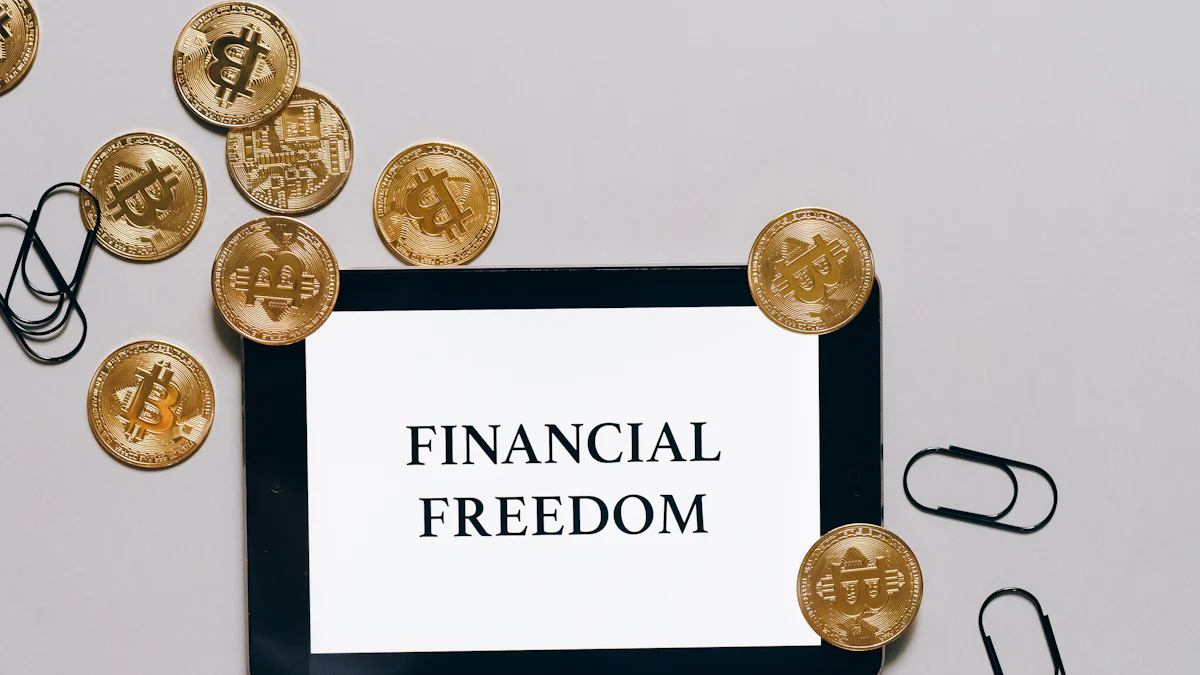Debt-Free in 2025: Proven Strategies to Pay Off Debt Faster

Imagine waking up in 2025 without the weight of debt holding you back. The average American carries over $104,000 in debt, with credit card balances alone averaging $6,501. These numbers can feel overwhelming, but taking control of your finances now can transform your future. Becoming debt-free in 2025 isn’t just about money—it’s about reclaiming your peace of mind. Dr. Gail Saltz explains that financial stress can lead to chronic health issues, including anxiety and depression. Eliminating debt brings emotional relief and a sense of freedom. Start today, and let 2025 be the year you achieve financial independence.
Key Takeaways
Write down all your debts, including amounts and interest rates. This helps you see everything clearly and plan better.
Pick a repayment plan that fits your goals. The snowball method gives quick wins, while the avalanche method saves on interest.
Watch your spending to find areas to save money. Small cuts can give you extra cash to pay off debt.
Try earning more money with side jobs or selling things you don’t need. Extra income helps you pay off debt faster.
Save for emergencies to avoid borrowing again. Having money for surprises keeps you on track to being debt-free.
Understanding Your Debt
Assess Your Financial Situation
List all debts, including balances and interest rates.
Start by creating a complete list of your debts. Include every loan, credit card balance, and outstanding bill. Write down the interest rate for each one. This step gives you clarity and helps you see where your money is going. For example, if you have credit card debt with a 20% interest rate, it’s likely costing you more than other types of debt. Knowing these details will help you prioritize repayment.
Calculate your total debt to understand the full picture.
Add up all your debts to calculate the total amount you owe. This number might feel intimidating, but it’s essential to face it head-on. Understanding the full picture allows you to set realistic goals. For instance, if your total debt is $50,000, you can break it into smaller, manageable milestones. This approach makes the journey less overwhelming and more achievable.
Identify Your Debt Type
Differentiate between secured and unsecured debt.
Debt falls into two main categories: secured and unsecured. Secured debt, like a mortgage or auto loan, is backed by collateral. If you default, the lender can seize the asset. Unsecured debt, such as credit card debt, doesn’t have collateral, so it carries higher interest rates. Prioritize secured debts to protect your assets while managing unsecured debts to avoid excessive interest charges.
Recognize high-interest vs. low-interest debt.
High-interest debt, like credit card debt, can quickly spiral out of control. Low-interest debt, such as a mortgage, is less urgent but still requires attention. Focus on paying off high-interest debt first to save money over time. For example, tackling a credit card balance with a 25% interest rate will reduce your financial burden faster than paying extra on a 3% mortgage.
Evaluate Your Spending Habits
Track income and expenses to identify patterns.
Track every dollar you earn and spend for at least a month. Use a notebook or a budgeting app to record your transactions. This process reveals patterns in your spending. You might discover that small, frequent purchases, like daily coffee runs, add up to hundreds of dollars each month. Awareness is the first step toward change.
Pinpoint areas where you can cut back.
Once you’ve tracked your spending, look for areas to cut back. Cancel unused subscriptions, wait 30 days before making big purchases, and focus on appreciating what you already have. These small changes can free up money to pay off debt faster. For example, cutting a $15 monthly subscription saves $180 a year—money that could go toward reducing your loan balances.
Proven Strategies to Pay Off Debt

Debt Snowball Method
Focus on paying off the smallest debts first.
The debt snowball strategy focuses on tackling your smallest debts first. Start by listing all your debts in order of balance, from smallest to largest. Pay the minimum on all debts except the smallest one, which you’ll attack with every extra dollar you can find. Once you pay off the smallest debt, move to the next one on the list. This approach builds momentum and keeps you motivated.
Build momentum and motivation with quick wins.
Paying off smaller debts quickly gives you a sense of accomplishment. Each "win" boosts your confidence and reinforces your commitment to becoming debt-free. The psychological benefits of this method are significant. You’ll feel empowered as you see tangible results, making it easier to stay on track. Many people find this strategy effective because it creates a positive mindset and encourages consistency.
Debt Avalanche Method
Prioritize paying off high-interest debts first.
The debt avalanche strategy targets high-interest debts first, saving you money in the long run. List your debts by interest rate, from highest to lowest. Focus on paying off the debt with the highest rate while making minimum payments on the rest. This method reduces the total interest you’ll pay over time, making it a cost-effective strategy.
Save more money on interest over time.
By prioritizing high-interest debts, you’ll save thousands of dollars. For example, using the debt avalanche strategy can save an average of $4,154 in interest compared to $3,845 with the debt snowball strategy. However, this method requires patience, as it may take longer to see progress. Staying disciplined is key to reaping the financial benefits.
Method | Interest Paid | Total Savings |
|---|---|---|
Debt Avalanche | $1,816 | $4,154 |
Debt Snowball | $2,125 | $3,845 |
Debt Consolidation
Combine multiple debts into one payment.
Debt consolidation simplifies your repayment process by merging multiple debts into a single monthly payment. This is especially helpful if you’re juggling several loans or credit card balances. A debt consolidation loan can streamline your finances and make it easier to stay organized.
Simplify payments and potentially lower interest rates.
Consolidation often comes with the added benefit of lower interest rates. For example, consolidating high-interest credit card debt into a fixed-rate loan can save you money over time. Common forms of debt consolidation include personal loans, balance transfer credit cards, and home equity loans. Focus on consolidating high-interest debts first to maximize savings. With one manageable payment, you’ll reduce stress and stay on track toward financial freedom.
Tip: Before choosing a debt consolidation loan, compare interest rates and terms to ensure you’re getting the best deal.
Increase Your Income
Take on side gigs or freelance work.
Boosting your income is one of the most effective ways to pay off debt faster. Side gigs or freelance work can provide the extra cash you need to accelerate your repayment journey. Platforms like Upwork, Fiverr, or DoorDash offer flexible opportunities to earn money on your schedule. Whether you’re skilled in graphic design, writing, or delivery services, there’s a gig for you.
However, it’s important to plan carefully. Freelance work often comes with income unpredictability. Some months may bring in more money than others, making it harder to stick to a consistent repayment plan. Additionally, consider insurance coverage. Without liability insurance, even minor incidents could lead to unexpected financial setbacks. Approach side gigs with a clear strategy to maximize their benefits while minimizing risks.
Sell unused belongings for extra cash.
Your home might be a treasure trove of untapped income. Selling unused belongings can generate quick cash to pay off debt. Look for items like old electronics, furniture, or clothing that you no longer need. Platforms like eBay, Facebook Marketplace, or Poshmark make it easy to connect with buyers.
This approach not only helps you declutter but also redirects money toward your financial goals. For example, selling a $200 unused gadget could cover a credit card payment or reduce a loan balance. Every dollar counts when you’re working toward debt freedom.
Cut Unnecessary Expenses
Reduce discretionary spending.
Cutting back on non-essential expenses is a powerful strategy to free up money for debt repayment. Start by reviewing your spending habits. Identify areas where you can scale back, such as dining out, entertainment subscriptions, or impulse purchases. For instance, preparing meals at home instead of eating out could save hundreds of dollars each month.
Small sacrifices add up quickly. Redirecting these savings toward your debt can make a significant impact over time. Remember, this isn’t about deprivation—it’s about prioritizing your long-term financial freedom.
Pause investments temporarily to redirect funds.
If you’re investing while carrying high-interest debt, consider pausing those contributions temporarily. Redirecting that money toward debt repayment can save you more in interest than you’d earn from investments. For example, paying off a credit card with a 20% interest rate offers a guaranteed return that’s hard to beat.
This doesn’t mean abandoning your financial future. Once you’ve paid off your debt, you can resume investing with greater confidence and more disposable income. Use this temporary pause as a strategic move to achieve your goal of becoming debt-free by 2025.
Tip: Always restart your investments as soon as your debt is under control to ensure you stay on track with your long-term financial goals.
How to Choose the Right Debt Repayment Strategy
Align with Your Financial Goals
Decide between speed and cost savings.
Choosing the right debt repayment strategy starts with understanding your financial goals. Do you want to pay off debt quickly or save money on interest? If speed motivates you, focus on strategies like the debt snowball method. This approach helps you achieve quick wins by eliminating smaller debts first. If saving money is your priority, the debt avalanche method is ideal. By targeting high-interest debt, you’ll reduce the total amount paid over time.
To align your strategy with your goals, create a detailed financial plan. Start by outlining your current financial status and objectives. Use a budgeting approach like the 50/30/20 rule to manage your finances effectively. Regularly assess your progress and adjust your plan as needed. Staying flexible ensures your strategy remains aligned with your evolving goals.
Consider your motivation and discipline level.
Your motivation and discipline play a crucial role in choosing a debt repayment strategy. If you thrive on small victories, the snowball method keeps you inspired. For those who prefer long-term savings, the avalanche method requires patience and consistency. Reflect on what drives you and choose a strategy that matches your mindset. This self-awareness helps you stay committed to your journey.
Match Strategies to Your Debt Profile
Use the avalanche method for high-interest debt.
If you’re dealing with high-interest debt, the avalanche method is a smart choice. By prioritizing debts with the highest interest rates, you’ll save more money in the long run. This strategy works well for individuals focused on minimizing costs. It’s especially effective for credit card balances or payday loans with steep interest rates.
Use the snowball method for small, manageable debts.
For smaller, manageable debts, the snowball method offers a psychological boost. Paying off these debts quickly builds momentum and keeps you motivated. This approach is perfect if you need encouragement to stay on track. It’s also a great way to simplify your finances by reducing the number of outstanding accounts.
Seek Professional Guidance
Consult a financial advisor for personalized advice.
A financial advisor can provide valuable insights tailored to your situation. They’ll help you prioritize debt payments, focusing on those with the highest interest rates first. Advisors also assist in creating a budget that balances necessary expenses with debt repayment. By analyzing your cash flow, they can identify problem areas and suggest improvements. Their expertise ensures you’re making informed decisions.
Explore nonprofit credit counseling services.
Nonprofit credit counseling services offer additional support for managing debt. Organizations like the NFCC and FCAA provide resources such as credit counseling, debt management plans, and housing counseling. These services are accredited and adhere to strict standards, ensuring you receive trustworthy guidance. Working with a counselor can simplify your repayment process and help you regain control of your finances.
Tip: Research nonprofit organizations to find one that meets your needs. Look for accreditations like NFCC standards or COA certification to ensure credibility.
Staying on Track to Become Debt-Free in 2025

Create a Realistic Budget
Allocate extra funds toward debt repayment.
A realistic budget is your roadmap to financial freedom. Start by including debt repayments as a regular part of your monthly plan. Allocate a specific amount to each debt, aiming to pay more than the minimum whenever possible. This approach minimizes interest costs and accelerates your progress. For example, if you have a credit card balance, paying an extra $50 each month can significantly reduce the time it takes to pay it off.
Adjust tax withholdings to increase take-home pay.
Review your tax withholdings to ensure you’re not overpaying. Adjusting them can increase your take-home pay, giving you more money to allocate toward debt repayment. Use this extra cash to tackle high-interest debts or make additional payments on loans. Every dollar counts when you’re working toward becoming debt-free.
Build an Emergency Fund
Save 3-6 months of expenses to avoid new debt.
An emergency fund protects you from unexpected expenses that could derail your progress. Start small by saving at least $500 for minor emergencies. Gradually build this fund to cover three to six months of essential living expenses, such as rent, utilities, and groceries. This safety net ensures you won’t need to rely on credit cards or loans during tough times.
Use sinking funds for specific future expenses.
Sinking funds are a powerful tool for managing occasional expenses. Set aside money regularly for predictable costs like car repairs, holiday gifts, or medical bills. For instance, saving $50 monthly can prepare you for a $600 car repair bill. This strategy helps you avoid surprise expenses that could add to your debt.
Stay Motivated
Celebrate small milestones along the way.
Debt repayment is a marathon, not a sprint. Celebrate your progress to stay motivated. Small milestones, like paying off a credit card or reducing a loan balance by $1,000, deserve recognition. Treat yourself to something simple, like a favorite meal or a movie night, to mark these achievements. Acknowledging your wins keeps you inspired and focused.
Visualize your debt-free future to maintain focus.
Keep your end goal in sight. Create a vision board or use a debt tracker to visualize your progress. For example, color in a chart as you pay off each debt. This visual reminder reinforces your commitment and helps you stay on track. Remember, every step brings you closer to the freedom and peace of a debt-free life.
Achieving financial freedom by 2025 starts with understanding your debt and choosing a strategy that aligns with your goals. Whether you prefer the quick wins of the snowball method or the long-term savings of the avalanche method, staying consistent is key. Building an emergency fund and creating a realistic budget will keep you on track while reducing financial stress.
The benefits of becoming debt-free are life-changing. You’ll enjoy improved financial health, higher credit scores, and the freedom to live life on your terms. As Nelson Mandela said, “Money won’t create success, the freedom to make it will.” Take the first step today—list your debts, set goals, and start your journey toward a brighter future.
See Also
Essential Insights on 2025 Credit Card Interest Rates
The Importance of Starting Your Finances Early
Daily Routines of Those Who Achieve Financial Success

